Boxe
Française in Milan since 1869
or
"History of a plagiarism"
The recent article published on the italian magazine “Samurai
Banzai” has rouse both a great interest in WMA both many different
questions.
For example the one on our supposition of plagiarism by Master Luigi
Carmine on the text of Louis Leboucher, the first published in
Milan on 1869 and the second in Paris 1844.
So we are here to finally demonstrate to the public our hypotesis that
from many years is carry on by many historians like Sylvain Salvini,
Arrigo Manusardi, his son Italo and his nephews Lorenzo.
This demonstration is the product of cooperation and collaboration among
Sylvain, Italo and Lorenzo.
We can start our
explaning with some historical news about manuals and their authors.
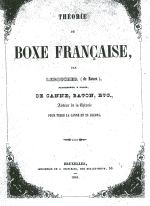 Louis Leboucher born in Rouen on 14 September 1807;
he’s one of the best and most important teacher of the XIX sec. in
France, in fact he published in 1843 his first tractise about Canne that
is also the first in France; after he published his “Theorie de la Boxe
Française et anglaise” (that from now we’ll call it L44) that it will
be reprint in Bruxelles in 1845 (L45) with new drawings (and it will be
reprint also in Paris with this drawings in 1853).
Louis Leboucher born in Rouen on 14 September 1807;
he’s one of the best and most important teacher of the XIX sec. in
France, in fact he published in 1843 his first tractise about Canne that
is also the first in France; after he published his “Theorie de la Boxe
Française et anglaise” (that from now we’ll call it L44) that it will
be reprint in Bruxelles in 1845 (L45) with new drawings (and it will be
reprint also in Paris with this drawings in 1853).
Really the “creator” of the Boxe Française seems could be linked to
Charles Lecour that, student of Michel dit Pisseux, learned before the
Savate and then the English Boxe and mixed themselves making in this way
the Boxe Française; but the origins of all this are still confused and
there’s not a book write by Lecour, so Leboucher become the most
important and “inspirator” of future masters.
Devost, successor of
Leboucher, print his treatise in 1882 (D82) imitating L44 including the
drawings and adding only a little part at the end of the book about
English box.
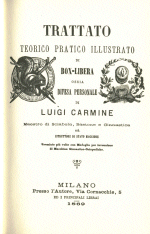 Luigi
Carmine published his “Trattato di Boxe libera ossia difesa
personale…” (C69) in 1869 to Milan; this
treatise is composed into five parts divided for topics and with 20
drawings at the end (in the original edition there’s the author’s
portrait too).
Luigi
Carmine published his “Trattato di Boxe libera ossia difesa
personale…” (C69) in 1869 to Milan; this
treatise is composed into five parts divided for topics and with 20
drawings at the end (in the original edition there’s the author’s
portrait too).
It’s very important ‘cause is one of the firsts
that explain something on the pugilism in Italy, also ‘cause in that
time was in evolution and not universally present like today! And touch
straight the self-defence, anticipating the current of Jiu-Jitsu that
across XIX and XX will be very considered.
Now, after our research,
we can assure that Carmine wrote a treatise of Boxe Française and Catch,
that with stick fencing and Jiu-Jitsu was called after Lutte Parisienne (unfortunately
both of this and Chausson nothing of wrote arrived to us, only in some
novel or little indication in more recent treatise).
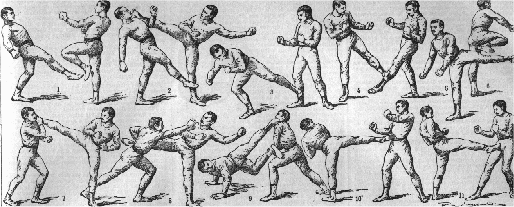
Now we can start our comparison with the drawings of
both text that first has wake up suspection!
L44 contain 16 drawings, different from L45 that has 18 drawings ‘cause
contain 2 new plates; in the first edition the characters wearing gloves
and white shirt with dark trousers, in the second are wearing always
different clothes but the positions are perfectly the same. For us
drawings of L45 are better and more well-finished.
C69 contain 20 drawings (and a portrait) and characters doesn’t wearing
gloves; but they wearing the same clothes of L44 and are very similar!
To a first observation they seems all the same but looking more we can see
some differences; so, only 11 are identical but not in the same order; a
curiosity: the coincidence wants that the only two
pair of plates with the same numbers (fig. 1 and fig. 1, fig. 14
and fig. 14) are a little different, could be a plague make at art??
Now you can see with yours eyes:
| Leboucher 1844 |
Carmine 1869 |
|
|---|---|---|
 Figura 1 |
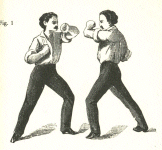 Figura 1 |
|
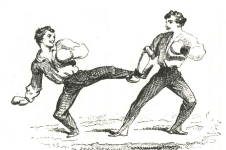 Figura 3 |
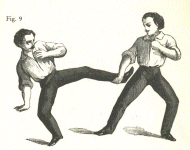 Figura 9 |
|
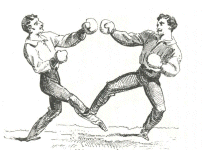 Figura 6 |
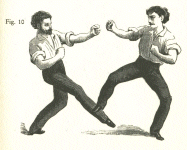 Figura 10 |
|
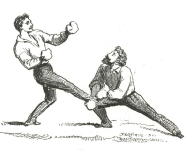 Figura 8 |
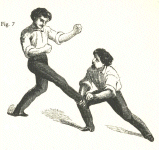 Figura 7 |
|
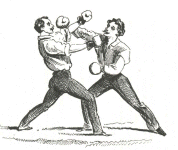 Figura 9 |
 Figura 3 |
|
 Figura 10 |
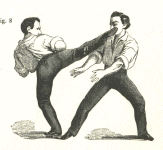 Figura 8 |
|
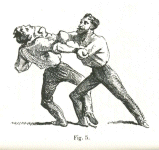 Figura 5 |
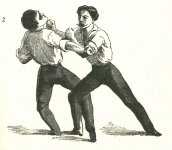 Figura 2 |
|
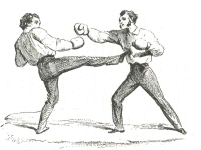 Figura 12 |
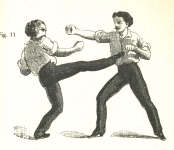 Figura 11 |
|
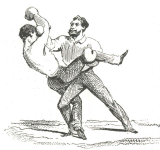 Figura 13 |
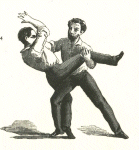 Figura 4 |
|
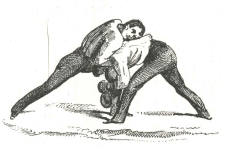 Figura 14 |
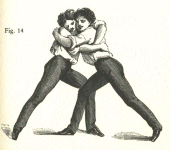 Figura 14 |
|
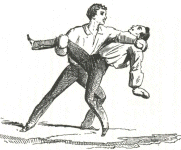 Figura 16 |
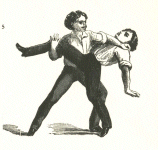 Figura 5 |
How you can see
resemblance is really extraordinary, only in the case of the two plates
numbered with red numbers there's some differences!
We left to the reader any personal consideration, only a clarification
that in C69 there are also 8 plates that we are studing and comparing with
other authors (personal position of Sylvain Salvini is that this plates
are taking from something of Leboucher, like students notes, 'cause he was
a great connoisseur of catch and wrestling! he was one of the men that
launch the great wrestler Arpin).
If comparing the drawings is spettacular, comparing the text sure isn't
less!!
Is allowed ask ourself if for the text Luigi Carmine had done the same do
for the plates: yes! he translate and rearranged, without to quotes the
original author, text af all the chapters!!
But he's got the "merit"
of in some case to summurize and to order in five differents parts:
"della guardia e della marcia"
(guard and movements),
"dei
colpi di pugno" (boxing), "dei colpi di gambe" (kicking),
"del gambetto" (kick up, to trip), "della lotta complicata"
(complicated catch (???)).
Here w can't write and compare all the chapters of both treatise but we
only scan some pages for example and we hope that intersted reader will
personally search for his personal curiosity.
We can start with first chapter about guard and movements (you will see
how Leboucher is mare careful and exhaustive than Carmine):
Guardia
Carmine
Guardia Leboucher
Marcia Carmine
Marcia Leboucher
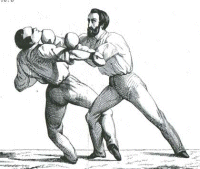 How
you can compare yourselves the similitude is really frightening; during
summer we will put other pages of example, like the last about catch and
self-defence that in some cases is similar and in other no; so you will
can see if you are reading something of new or only text reading yet!
How
you can compare yourselves the similitude is really frightening; during
summer we will put other pages of example, like the last about catch and
self-defence that in some cases is similar and in other no; so you will
can see if you are reading something of new or only text reading yet!
So we can say that the treatise of Luigi Carmine can be considered the
first italian treatise about Savate defence or something of
similar; could be the only treatise in XIX sec. about Lutte
parisienne ?? maybe... But we have the proof that Savate is
entering in Italy about 30 years before what we was thinking!! In fact the
book was printed in 1869 in Milan! this can put in evidence that there was
someone that knowed Savate not in Genova, so how long we have to believe
that sailors men from Marsiglia teach to sailors of Genova at the end of
1800?
It was a pity that Luigi Carmine don't say nothing about the teaching
method in a note or under the title (like Devost with "method
Leboucher"); could be predispose our italian savateurs
| < Back |
Menus |